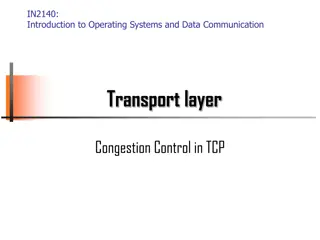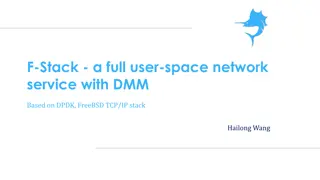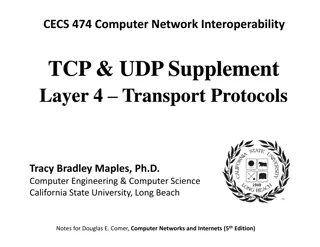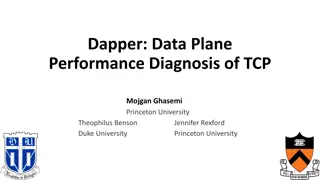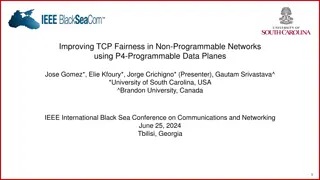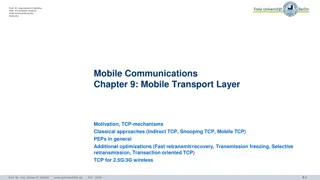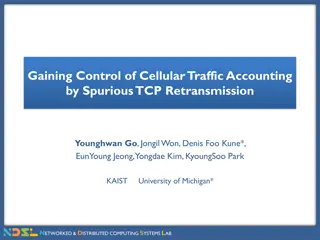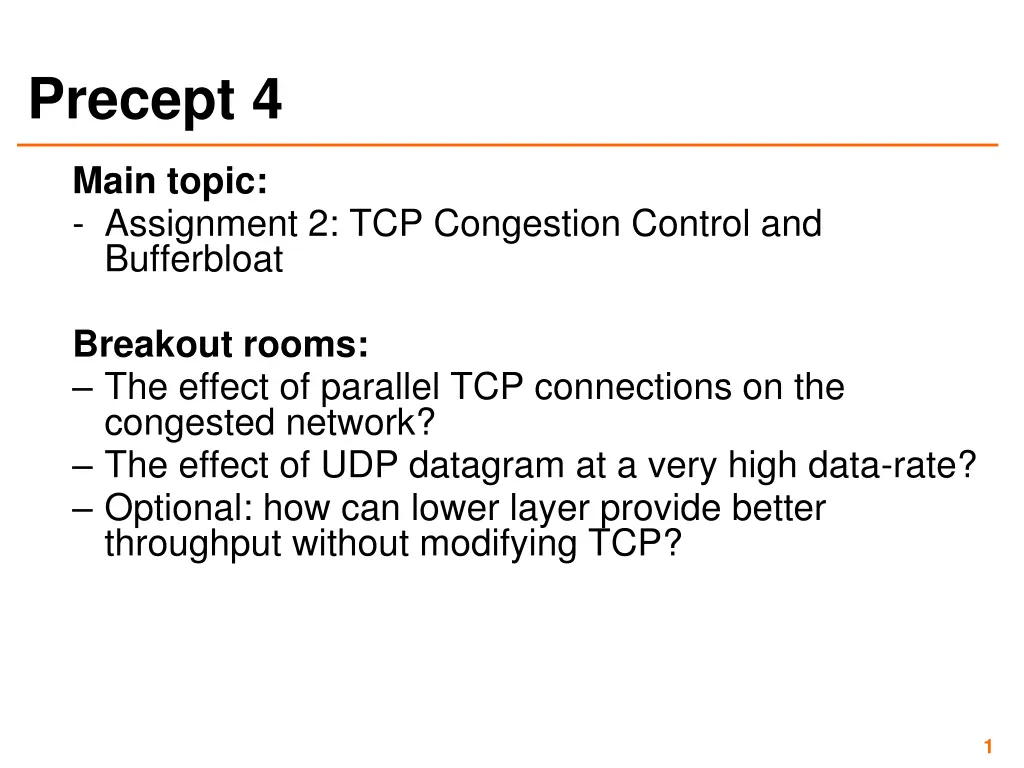
Understanding TCP Congestion Control for Enhanced Network Performance
Explore the impact of parallel TCP connections, UDP datagrams, and lower layer optimizations on network throughput. Learn about TCP congestion window size, congestion detection, bandwidth utilization, and TCP variants like Tahoe and Reno.
Download Presentation

Please find below an Image/Link to download the presentation.
The content on the website is provided AS IS for your information and personal use only. It may not be sold, licensed, or shared on other websites without obtaining consent from the author. If you encounter any issues during the download, it is possible that the publisher has removed the file from their server.
You are allowed to download the files provided on this website for personal or commercial use, subject to the condition that they are used lawfully. All files are the property of their respective owners.
The content on the website is provided AS IS for your information and personal use only. It may not be sold, licensed, or shared on other websites without obtaining consent from the author.
E N D
Presentation Transcript
Precept 4 Main topic: - Assignment 2: TCP Congestion Control and Bufferbloat Breakout rooms: The effect of parallel TCP connections on the congested network? The effect of UDP datagram at a very high data-rate? Optional: how can lower layer provide better throughput without modifying TCP? 1
TCP Congestion Window Size cwnd - the TCP congestion window size parameter maintained by the sender determines how much traffic can be outstanding (sent but not acknowledged) at any time. There are many algorithms for cwnd Goal: maximizing the connection's throughput while preventing congestion. Tahoe, Reno, New Reno, SACK, CUBIC 2
Congestion detection Time-out - lost packets (e.g. buffer overflow at routers) 3-ACKs - long delays (e.g. queueing in router buffers) less severe since 1 segment is missing but 3 other segments have been received Source: TCP/IP Protocol Suite 4th 3
Bandwidth Utilization How much time is needed increase cwnd of a 10Gbps from half utilization to full utilization? 1500-byte PDU 100 ms RTT Full utilization cwnd = 10Gbps/1500byte ~=83333 Half utilization cwnd = 83333/2 = 41666.5 If cwnd is increased by 1 for each RTT 41667 RTT is needed to fully utilized the link 41667 RTT * 100ms(RTT time) = 69.44minutes
Tahoe TCP Per RTT (per window): if(cwnd < ssthresh) cwnd *= 2 else cwnd += 1 timeout/3rddup ack: Retransmit all unacked. ssthresh = cwnd/2 cwnd = 1 Packets still getting through in dup ack no need to reset the cwnd! 5
Reno TCP Per RTT (per window): : If(cwnd < ssthresh) cwnd *= 2 else cwnd += 1 timeout: Retransmit 1stunacked ssthresh = cwnd/2 cwnd = 1 3rddup ack: Retransmit 1stunacked ssthresh = cwnd/2 cwnd = ssthresh + 3 Fast Recovery: the pipe is still almost full no need to restart 6
Problem with Reno Multiple packet losses within a window of data Terminates recovery prematurely Deflates cwnd to ssthresh Detection of second loss relies on another fast retransmission But with much less incoming dup ACKs Much less new data packets begin sending out Lose self-clocking 7
New Reno TCP Idea: use partial ACKs to stay in fast recovery and fix more lost segments 3rd dup ack: Retransmit 1st unacked ssthresh = cwnd/2 cwnd = cwnd/2 + 3 subsequent dup ack: cwnd++ complete ack: cwnd = ssthresh partial ack: retransmit cwnd = ssthresh sender receiver pkt x pkt x+1 pkt x+2 pkt y pkt x 8
Problem with New Reno TCP uses cumulative ACKs Receiver identifies the last byte of data successfully received Out of order segments are not ACKed Receiver sends duplicate ACKs TCP forces the TCP sender To wait an RTT to find out a segment was lost To unnecessarily retransmit data that has been correctly received ? reduced overall throughput 9
SACK TCP Selective Ack (SACK) + Selective Retransmission Policy Receiver informs sender about all segments that are successfully received Sender fast retransmits only the missing data segments Can recover more than one packet losses per RTT since sender now knows which packets are dropped 10
CUBIC TCP Packet loss event Cubic starts probing for more bandwidth Fast growth upon reduction wmax: Window size just before the last reduction : Multiplicative decrease factor T: Time elapsed since the last window reduction C: A Scaling constant cwnd: The congestion window at the current time 11
Bufferbloat A switching device is configured to use excessively large buffers to avoid losing packets ? high latency and jitter. This can happen even in a typical home network Here, the end host in the home network is connected to the home router. The home router is then connected, via cable or DSL, to a headend router run by the Internet service provider (ISP). 12
Bufferbloat TCP sender sends until they see lost packet but if the buffer is large, the senders is unable to see the lost packets until this buffer has already filled up TCP sender sends at increasingly faster rates until they see a lost, then the sending rate is already much larger than the network s capacity. Buffer experiences the increasing delay ISP Modem Buffer 13
Questions for Thought How can parallel TCP connections help congested network? Can they hurt the performance instead? What happens if one of clients sends UDP datagram at a very high data- rate? How can lower layer provide better throughput without modifying TCP?
Probing for Throughput: TCP BBR BBR: TCP Congestion Control Protocol introduced by Google BBR does not use packet loss to determine congestion Estimates bottleneck bandwidth by measuring packet delivery rate. 15




